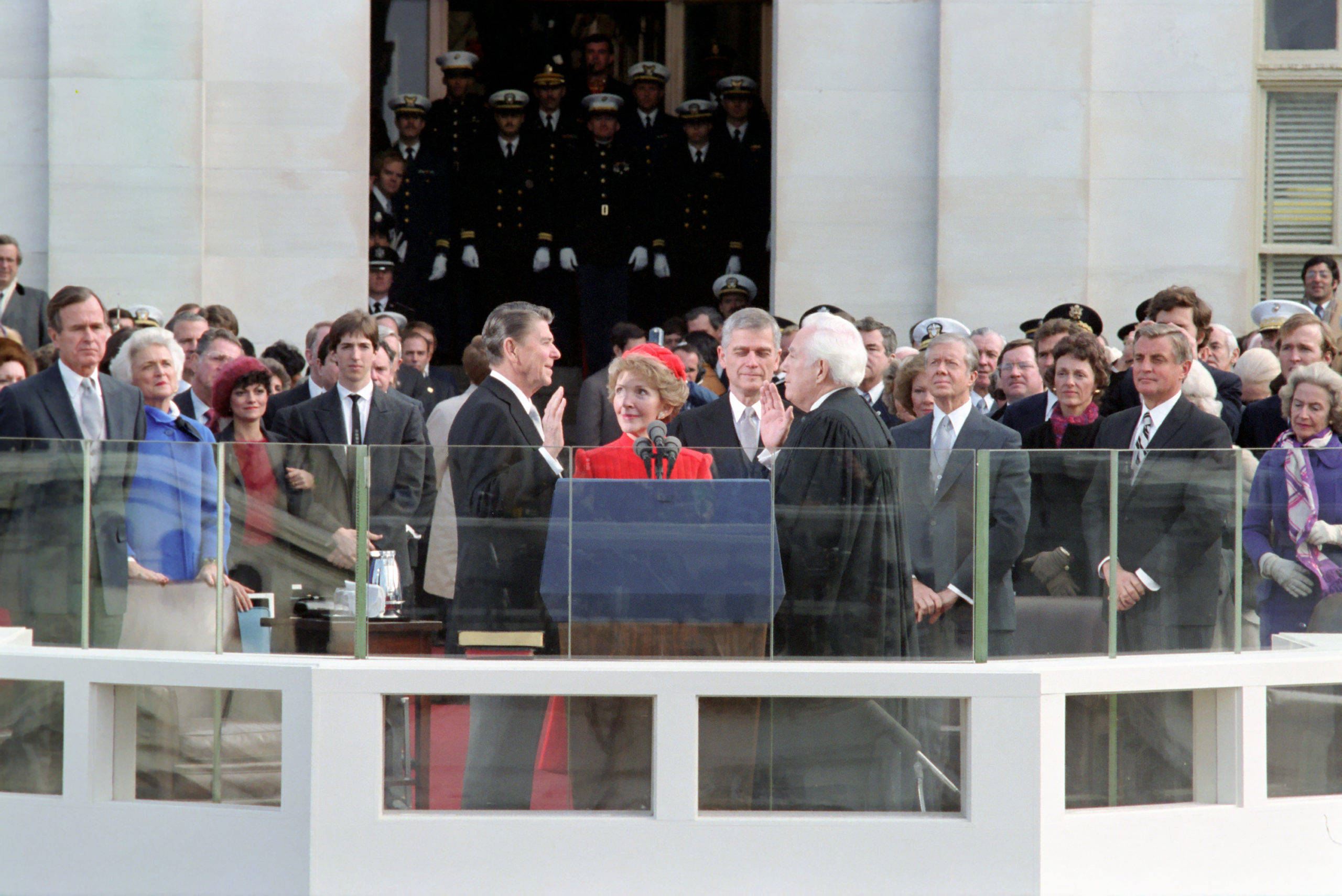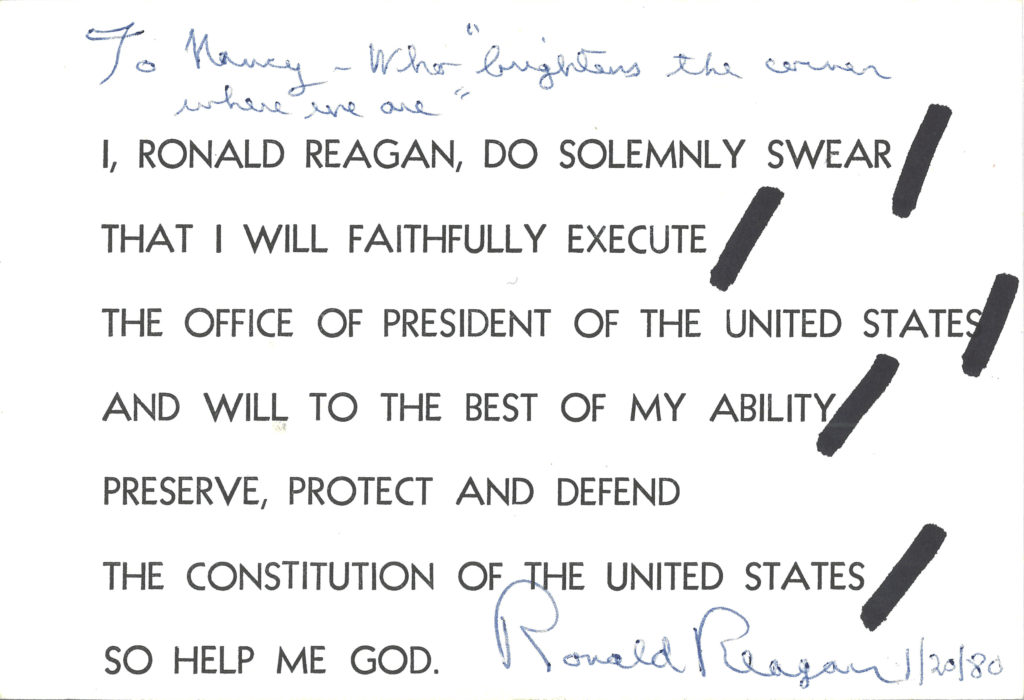
Ronald Reagan’s original presidential oath card which he signed and gave to long-time friend and associate Nancy Clark Reynolds January 20th, 1981.
On January 20th, 1981, Ronald W. Reagan took the oath of office administered by Chief Justice Warren Burger and became the 40th President of the United States of America. Commonly referred to as “The Great Communicator” for his ability to convey powerful messages in an understandable way, Reagan came from humble beginnings.1
On February 6, 1911, Reagan was Born in Tampico, Illinois, to parents Jack and Nelle.2 They struggled financially and moved frequently in pursuit of stable and better paying work. However, despite these low beginnings without the luxury of wealth or status, Reagan developed a charismatic charm and was blessed with a commanding stature, both of which would be pertinent for his future success.
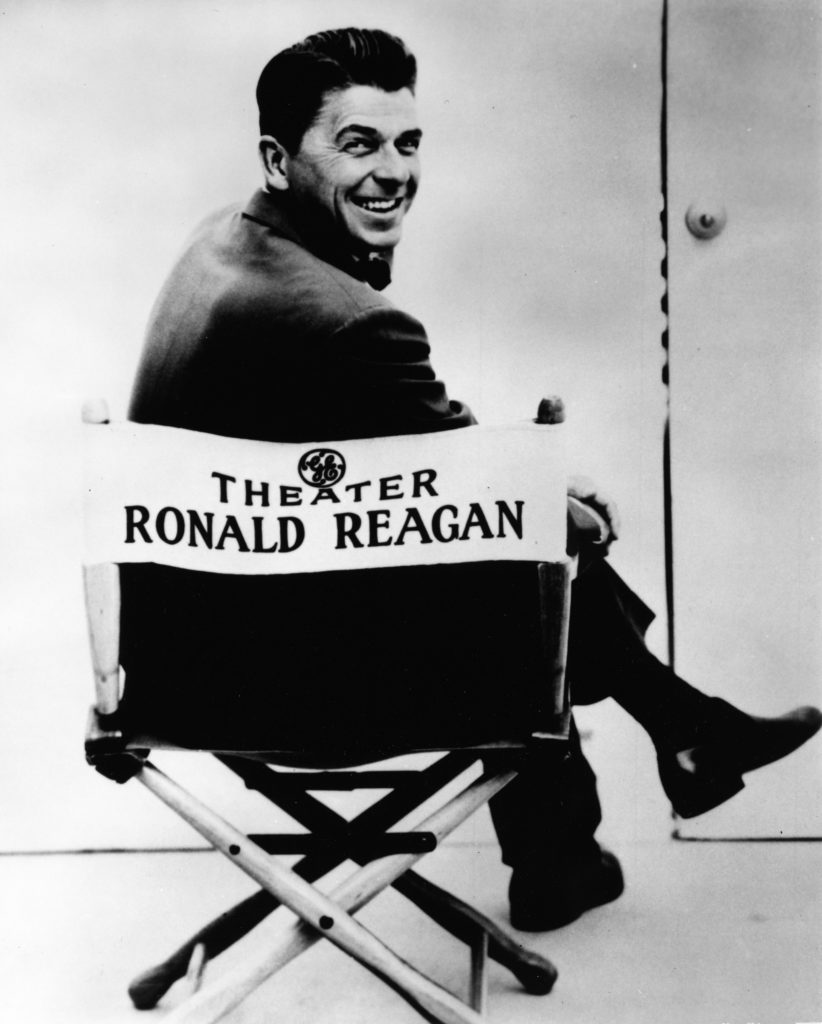
After graduating in 1932 from Eureka College, Reagan took multiple jobs as a radio announcer in Iowa, and later moved to WHO radio as an announcer for the Chicago Cubs.3 While on a business trip to California in 1937, Reagan took a screen test which resulted in Warner Brother’s giving him a seven-year acting contract.4 Starting as a main protagonist in the 1937 film Love is on the Air, he became highly sought after and made appearance in 19 films in two years.5
In 1940, Reagan married fellow actor Jane Wyman after performing together on the set of Brother Rat. After 8 years of marriage, Wyman and Reagan divorced.6 In the divorce proceeding, Wyman explained that part of the problem was that, “In recent months my husband and I engaged in continual arguments on his political views.”7 Ironically, at the time Wyman was Republican while Reagan was a devoted democrat! Wyman later went on to twice marry and divorce Frederick Karger.8 In all, she married five times in her life, and remained unmarried after her final divorce in 1965.9 In 1952, Reagan married Nancy Davis, who would remain his wife until his death.10
Altogether, Reagan spent nearly 30 years in the entertainment industry starring in more than 50 films, appearing in television specials, and narrated numerous series.11 His acting career solidified a spot for him in the heart of Americans nationwide, in addition to radically growing his name recognition just in time for a different and more polarizing ambition.
Reagan’s entry into the national political spotlight came in 1963, when he gave a speech entitled “A Time for Choosing”, supporting Arizona U.S. Senator Berry Goldwater for president. In the speech, Reagan explained why he was now a Republican after having been a staunch Democrat for so many years. He said:
I have spent most of my life as a Democrat. I recently have seen fit to follow another course. I believe that the issues confronting us cross party lines.… If we lose freedom here, there is no place to escape to. This is the last stand on Earth. And this idea that government is beholden to the people, that it has no other source of power except to sovereign people, is still the newest and most unique idea in all the long history of man’s relation to man. This is the issue of this election. Whether we believe in our capacity for self-government or whether we abandon the American revolution and confess that a little intellectual elite in a far-distant capital can plan our lives for us better than we can plan them ourselves.12
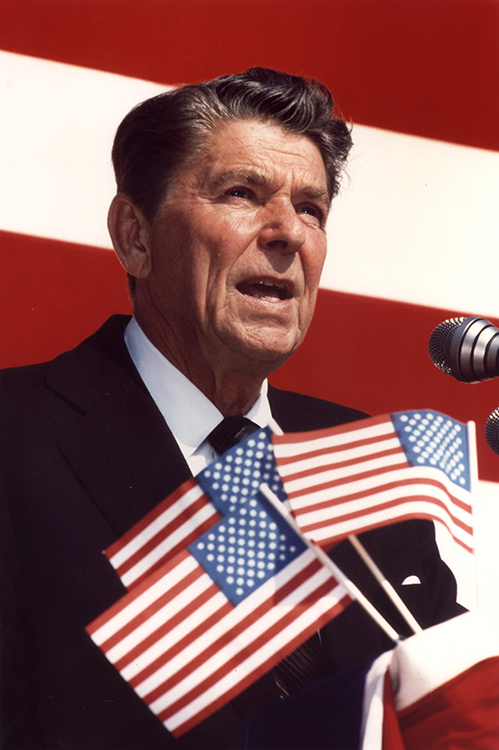
Though Goldwater ultimately failed to win the general election, Republicans from around the nation recognized Reagan as a future candidate for high office. In 1966, he ran a successful campaign for governor of California against Pat Brown, an incumbent Democrat, and won by nearly one-million votes.13
With Reagan’s triumphant entry into high statewide office, he passed numerous measures aimed at shrinking the state government and balancing the state’s budget through changes in fiscal policy. In his second term as governor, he worked with a democratic majority in the state assembly to lower the total number of citizens on government assistance while improving services for those who remained.14 Reagan declined to run for a third term as governor of California, but his greatest political responsibility was yet to come.
On November 20th, 1975, Reagan announced his candidacy for president of the United States, marking his first attempt at the nation’s highest office:
We, as a people, aren’t happy if we are not moving forward. A nation that is growing and thriving is one which will solve its problems. We must offer progress instead of stagnation; the truth instead of promises; hope and faith instead of defeatism and despair. Then, I am sure, the people will make those decisions which will restore confidence in our way of life and release that energy that is the American spirit.15
In the following year, he made his case to the American public for a stronger nation, promising lower taxes, opposing expansion of federal bureaucracy, and assuring a new way forward.16 However, Reagan could not overcome support Gerald Ford had accumulated during his tenure as Vice President to Richard Nixon and failed to obtain his party’s presidential nomination. Ultimately, Jimmy Carter, the democratic presidential nominee, was able to defeat Ford the 1976 general election.
Carter’s presidency, however, proved to be a disaster. Inflation surged, gasoline shortages plagued the nation, and national embarrassments such as a failed hostage extraction operation.17 In Carter’s eyes, Americans were suffering from a “Crisis of Confidence” and he was correct18. His attempts at convincing the country of his ability to wield this office had faded to irreparable proportions, and Reagan knew that.
In 1980, Reagan handily won the Republican primary presidential nomination. His general election campaign resonated with voters across the nation and defeated Carter in a resounding electoral college victory, winning 489 out of the 538 total electoral votes.19
When he took the oath of office on January 20, 1981, this card was used in the ceremony. The black slashes were included to mark where Chief Justice Warren E. Burger would stop so Reagan could repeat that section.
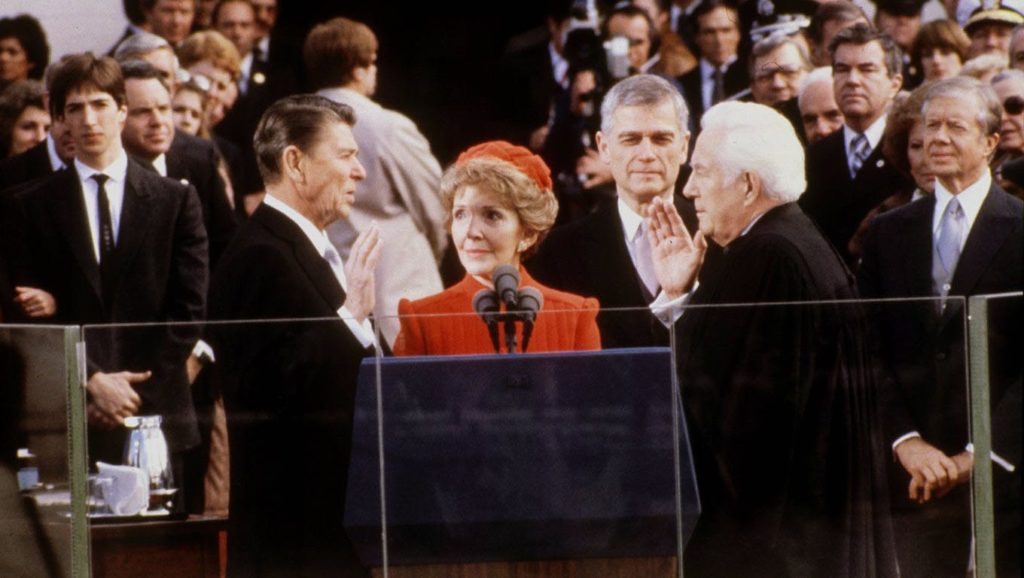
In his inaugural address, Reagan once again encouraged Americans that their future would be brighter than their past, and that the shackles which bound the economy and industry of the country would be broken. The “Great Communicator” explained that:
It is no coincidence that our present troubles parallel and are proportionate to the intervention and intrusion in our lives that result from unnecessary and excessive growth of government. It is time for us to realize that we’re too great a nation to limit ourselves to small dreams. We’re not, as some would have us believe, doomed to an inevitable decline. I do not believe in a fate that will fall on us no matter what we do. I do believe in a fate that will fall on us if we do nothing. So, with all the creative energy at our command, let us begin an era of national renewal. Let us renew our determination, our courage, and our strength. And let us renew our faith and our hope. We have every right to dream heroic dreams. Those who say that we’re in a time when there are not heroes, they just don’t know where to look.20
After the inauguration, Reagan signed and gifted his oath card to longtime friend and former aide Nancy Clark Reynolds.21 Reynolds served as Reagan’s assistant press secretary from 1966-1968 while he was Governor of California, and special assistant from 1968-1974.22 In 1974, she departed from that role and became a corporate executive.23 In 1987, after winning reelection for the presidency, Reagan appointed Reynolds to serve on the National Museum Services Board for a term of four years.24
Reagan personalized the oath card with the message “To Nancy – Who ‘brightens the corner where we are.’”25 In a small mistake many of us might relate to, Reagan dated the card “1/20/80” even though his inauguration was in 1981. Another distinctive feature about Reagan’s oath card is that it has the additional phrase, “So help me God,” included in the oath. Although not required by the Constitution, this phrase has traditionally been a part of the presidential oath of office since the first inauguration of George Washington in 1789.26
[1] Ronald Reagan, Speaking My Mind (New York City: Simon & Schuster Paperbacks, 1989), 412.
[2] Michael Ward, “National Register of Historic Places Inventory – Nomination Form,” 1981, United States Department of the Interior (Accessed Feb. 1, 2022): https://web.archive.org/web/20160121053026/http://gis.hpa.state.il.us/PDFs/201351.pdf.
[3] H. W. Brands, Reagan: The Life (New York City: Penguin Random House, 2015), 24-31
[4] H. W. Brands, Reagan: The Life (New York City: Penguin Random House, 2015), 24-31
[5] “Ronald Reagan’s Filmography”, Reagan Library (Accessed Feb. 2, 2022) https://www.reaganlibrary.gov/reagans/ronald-reagan/ronald-reagans-filmography; H. W. Brands, Reagan: The Life (New York City: Penguin Random House, 2015), 24-31.
[6] “Biography,” Jane Wyman (Accessed Feb. 3, 2022): https://www.jane-wyman.com/biography.html.
[7] Quoted in, David Byrne, Ronald Regan: An Intellectual Biography (Lincoln: Potomac Books, 2018), 22. Here.
[8] “Jane Wyman Divorced,” The New York Times (Accessed Feb. 3, 2022) https://www.nytimes.com/1965/03/10/archives/jane-wyman-divorced.html.
[9] “Biography” Jane Wyman (Accessed Feb. 3, 2022) https://www.jane-wyman.com/biography.html.
[10] “Nancy Davis Reagan, The White House (Accessed Feb. 3, 2022) https://georgewbush-whitehouse.archives.gov/history/firstladies/nr40.html.
[11] “Ronald Reagan’s Filmography”, Reagan Library (Accessed Feb. 2, 2022), https://www.reaganlibrary.gov/reagans/ronald-reagan/ronald-reagans-filmography.
[12] Ronald Reagan, “Address on Behalf of Senator Goldwater: A Time for Choosing,” October 27, 1964, The American Presidency Project (accessed February 4, 2022) https://www.presidency.ucsb.edu/documents/address-behalf-senator-barry-goldwater-time-for-choosing.
[13] “Ronald Wilson Reagan was born February 6, 1911, in Tampico, Illinois.” The Governors’ Gallery (Accessed Feb. 2, 2022) https://governors.library.ca.gov/33-reagan.html.
[14] Jackson K. Putnam, Governor Reagan: A Reappraisal (Berkeley: University of California Press, Feb. 2, 2022)26
[15] “Ronald Reagan Announcement for Presidential Candidacy”, Reagan Library (Accessed Feb. 3, 2022): https://www.reaganlibrary.gov/archives/speech/ronald-reagan-announcement-presidential-candidacy.
[16] “Ronald Reagan Announcement for Presidential Candidacy”, Reagan Library (Accessed Feb. 3, 2022): https://www.reaganlibrary.gov/archives/speech/ronald-reagan-announcement-presidential-candidacy.
[17] “Jimmy Carter served as the 39th President of the United States from 1977 to 1981”, The White House (Accessed Feb. 3, 2022) https://www.whitehouse.gov/about-the-white-house/presidents/james-carter/.
[18] “July 15, 1979: ‘Crisis of Confidence’ Speech” Miller Center (Accessed Feb. 3, 2022), https://millercenter.org/the-presidency/presidential-speeches/july-15-1979-crisis-confidence-speech.
[19] “1980 Electoral College Results” National Archives (Accessed Feb. 3, 2022), https://www.archives.gov/electoral-college/1980
[20] Ronald Reagan, “Inaugural Address,” January 20, 1981, The American Presidency Project (accessed February 4, 2022): https://www.presidency.ucsb.edu/documents/inaugural-address-11.
[21] Ronald Reagan, Oath of Office Document Signed by Ronald Reagan, Glenn Beck Private Collection, American Journey Experience, Irving, Texas.
[22] “Nomination of Nancy Clark Reynolds To Be a Member of the National Museum Services Board” The American Presidency Project (Accessed Feb 3, 2022) https://www.presidency.ucsb.edu/documents/nomination-nancy-clark-reynolds-be-member-the-national-museum-services-board.
[23] “Nomination of Nancy Clark Reynolds To Be a Member of the National Museum Services Board” The American Presidency Project (Accessed Feb 3, 2022) https://www.presidency.ucsb.edu/documents/nomination-nancy-clark-reynolds-be-member-the-national-museum-services-board.
[24] “Nomination of Nancy Clark Reynolds To Be a Member of the National Museum Services Board” The American Presidency Project (Accessed Feb 3, 2022) https://www.presidency.ucsb.edu/documents/nomination-nancy-clark-reynolds-be-member-the-national-museum-services-board.
[25] Ronald Reagan, Oath of Office Document Signed by Ronald Reagan, Glenn Beck Private Collection, American Journey Experience, Irving, Texas.
[26] See, United States Constitution, Article II, Section I, Clause 8; Washington Irving, Life of George Washington (New York: G. P. Putman, 1865) 4.475; “Philadelphia, May 8. Extract of a Letter from New York, May 3,” Gazette of the United States (May 9 to May 13, 1789), 35.

